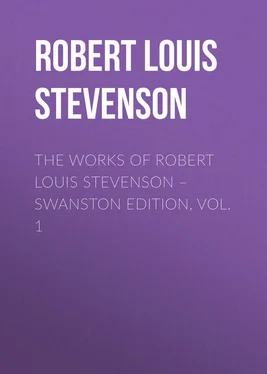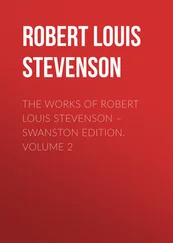Роберт Льюис Стивенсон - The Works of Robert Louis Stevenson – Swanston Edition, Volume 1
Здесь есть возможность читать онлайн «Роберт Льюис Стивенсон - The Works of Robert Louis Stevenson – Swanston Edition, Volume 1» — ознакомительный отрывок электронной книги совершенно бесплатно, а после прочтения отрывка купить полную версию. В некоторых случаях можно слушать аудио, скачать через торрент в формате fb2 и присутствует краткое содержание. Жанр: foreign_prose, foreign_antique, на английском языке. Описание произведения, (предисловие) а так же отзывы посетителей доступны на портале библиотеки ЛибКат.
- Название:The Works of Robert Louis Stevenson – Swanston Edition, Volume 1
- Автор:
- Жанр:
- Год:неизвестен
- ISBN:нет данных
- Рейтинг книги:4 / 5. Голосов: 1
-
Избранное:Добавить в избранное
- Отзывы:
-
Ваша оценка:
- 80
- 1
- 2
- 3
- 4
- 5
The Works of Robert Louis Stevenson – Swanston Edition, Volume 1: краткое содержание, описание и аннотация
Предлагаем к чтению аннотацию, описание, краткое содержание или предисловие (зависит от того, что написал сам автор книги «The Works of Robert Louis Stevenson – Swanston Edition, Volume 1»). Если вы не нашли необходимую информацию о книге — напишите в комментариях, мы постараемся отыскать её.
The Works of Robert Louis Stevenson – Swanston Edition, Volume 1 — читать онлайн ознакомительный отрывок
Ниже представлен текст книги, разбитый по страницам. Система сохранения места последней прочитанной страницы, позволяет с удобством читать онлайн бесплатно книгу «The Works of Robert Louis Stevenson – Swanston Edition, Volume 1», без необходимости каждый раз заново искать на чём Вы остановились. Поставьте закладку, и сможете в любой момент перейти на страницу, на которой закончили чтение.
Интервал:
Закладка:
Many scraps written by him in circumstances like these used to exist; some of them, though brief, were rich in the simple eloquence of indignation.
Almost no climate did him any good: in 1880-1881, he chiefly suffered at Davos, and in the tempests of September, in Braemar. At Davos he had few consolations except the society of Mr. J. A. Symonds (the Opalstein of his essay on "Talk and Talkers") and his family. He was still attached to the indigent Muse of History: meditating a "History of the Highlands," and another book on that much trampled topic, the Union of 1707. When one thinks of the commercial statistics necessary to the student of the Union—to take that grim aspect of it alone— enfin , "I have been there, and would not go." In the nature of things the History of the Union would have become a romance, with that impudent, entertaining rogue, Ker of Kersland, and his bewildered Cameronians, for the heroes: with Hamilton the waverer, and the dark, sardonic Lockhart of Carnwath, and Daniel Defoe as the English looker-on. The study of Highland history led to the reading of the Trial of James of the Glens, and the vain hunt for Alan Breck, and so to "Kidnapped."
Stevenson felt and described the exhilaration of Alpine mornings, but his style was as sensitive as his bronchial apparatus, and he declares that when he tried to write, the style suffered from "yeasty inflation," while his nights were haunted by the nightmares of his childhood.
The next change carried him to a cottage near Pitlochry, whence he wrote that he was engaged in the composition of "crawlers." The first and best of these, "Thrawn Janet," was (with his "Tod Lapraik" in "Kidnapped") the only pendant to Scott's "Wandering Willie's Tale," in the northern vernacular. The tale has a limited circle; no Southern can appreciate all its merits, the thing is so absolutely and essentially Scots; especially the atmosphere. He said that it was "true for a hill parish in Scotland in old days, not true for mankind and the world." So it is fortunate to be a native of a hill parish in Scotland!
"The Merry Men," as "a fantasia or vision of the sea," is excellent; the poor negro never was, to myself, "convincing." However, knowing Stevenson's taste in art, I designed for him, in Skeltic taste, an illustration (coloured) of the negro pursuing the wicked uncle (in the philabeg) over the crests of Ben Mor, Mull.
Descending from these heights, Stevenson, like every bookish Scot, "ettled at" a professorial chair—that of "History and Constitutional Law," in the University of Edinburgh.
The election was in the winter, the legist and historian occupied the autumn in composing the first half of "Treasure Island" (originally "The Sea Cook").
Everyone knows the story: how, playing with his stepson, Stevenson drew a map of an island—an island like a dragon seyant ; considered the caves and hills and streams, and thought of the place as a haunt of these serviceable pirates, who always dumped down their hard-earned swag on distant and on deadly shores, which they carefully abstained from revisiting. The legends of Captain Kidd's caches have long haunted the imagination; the idea of Hidden Treasure has its eternal charm, and the story thereof was told, once for all, by Poe. Soon after "Treasure Island" appeared there was a real treasure hunt. The deposit, so I was informed, was "put down by a Fin," and Mr. Rider Haggard and I were actually paying (at least Mr. Haggard sent me a cheque) for shares in this alluring enterprise, when I learned that the Fin (or Finn? a native of Finland), had looted the church plate of some Spanish cathedral in America. Knowing this, I returned his cheque to Mr. Haggard; happily, for the isle was the playroom of young earthquakes, which had upset the soil and the landmarks to such a degree that the gentleman adventurer returned— bredouille ! I hope Stevenson had nothing on.
In the Highland cottage, during the rain eternal, he amused himself with writing his story, as Shelley, Byron, Polidori, and Mary Godwin had diverted themselves in Swiss wet weather, with their ghost stories, "Frankenstein," and Byron's good opening of a romance of a vampire.
Visitors came—Mr. Colvin, Mr. Gosse, and Dr. Japp—they liked the tale as chapter by chapter was read aloud, and it was offered to a penny periodical for boys. A much better market might easily have been found; indeed, Stevenson "wasted his mercies." He was paid like the humblest of unknown scribblers; not even illustrations were given to the obscure romance running in dim inner pages of the periodical, and it appears that, as Théophile Gautier's editor said about one of his narratives, "the abonné was bored with the style."
It was an audacious thing for a man of Louis's health, and intermittent inspiration, to send in half the "copy," meaning to send the rest later from Davos. He might not be able, physically, to write—the inspiration might vanish—and there was John Addington Symonds, eager for him to write on the "Characters" of Theophrastus! He might as well have written, or better, on the "Characters" of Sir Thomas Overbury, which are rather less remote from the ken of the British public than those of the Greek.
If any young man or woman, not in possession of independent means, reads these lines of mine, let him or her take warning, and deserting history, morals, the essay, biography, and shunning anthropology as they would kippered sturgeon or the devil, cleave only to fiction!
Biography also allured Stevenson—his literary tastes were nearly his ruin; he wanted, at Davos, to write a "Life of Hazlitt," and at Bournemouth a biography of Arthur, Duke of Wellington. But time and strength were lacking; nor have we R. L. S.'s mature opinion of the strategy and tactics of the victor of Assaye. The Muse of piratical enterprise returned, and "Treasure Island" reached its haven, with no applause, in the paper for boys.
In the following May, Messrs. Cassell proposed to publish "Treasure Island" in book form, being spirited up, I suppose, by Mr. Henley, who was editing for them "The Magazine of Art," in which Stevenson wrote two or three articles. (I remember that a letter of my own to "The Editor," as Mr. Henley had proudly signed himself, came automatically into the hands of the General Editor, a clergyman, if I do not err, and that my observations on the Art of Savages, lighting on the wrong sort of ground, sprang up and nearly choked Mr. Henley.) Stevenson was already the victim of the Yankee pirate, whose industry, at least, made his name, though wrongly spelled, known to the community which later paid him so well for his work, and displayed for him an enthusiasm of affectionate admiration.
In 1884 he worked at the often rewritten "Prince Otto," and did a pot-boiler—"The Black Arrow"—which pleased the boy public of the paper much better than "Treasure Island." His time, from January, 1883, to May, 1884, was passed at Hyères. In the end of November, "Treasure Island" was published in book form, and was warmly welcomed by the Press and by such friends of the author as retained, at least in letters, any smack of youth. It was forced, as far as "You must read it, please," even on the friends of the friends, and so on in successive waves, yet it did not reach a wide circle: five or six thousand copies were sold in the first year. That is failure in the eyes of many of our novelists whose style does not bore the unfastidious abonné. Stevenson, in writing an article for a magazine on his "First Book," chose "Treasure Island," for books other than novels do not count as books. He spoke of terror as the motive and interest of the tale; the dread for each and all of a mutiny headed by his ruthless favourite, John Silver. Indeed, terror, whether caused by the eccentric furies of Mr. William Bones, mariner, or of the awful blind Pew with his tapping staff, runs through the volume as the dominant motive. But there is so much else: the many landscapes, so various and so vivid; the humour of the Doctor and the Squire, the variety of the seamen's characters; the Man of the Island, with his craving for a piece of cheese; above all, John Silver. He is terrible, this coldly cruel, crafty, and masterful Odysseus of the Pacific. His creator liked him, but I could have seen Silver withering on the wuddie at Execution Dock, or suspended from a yardarm, without shedding the tears of sensibility. "A pirate is rather a beast than otherwise," says a young critic in "The Human Boy," and I cannot get over Silver gloating on the prospect of torturing Trelawny. At all events, he is an original creation, and a miraculous portent in a boy's book.
Читать дальшеИнтервал:
Закладка:
Похожие книги на «The Works of Robert Louis Stevenson – Swanston Edition, Volume 1»
Представляем Вашему вниманию похожие книги на «The Works of Robert Louis Stevenson – Swanston Edition, Volume 1» списком для выбора. Мы отобрали схожую по названию и смыслу литературу в надежде предоставить читателям больше вариантов отыскать новые, интересные, ещё непрочитанные произведения.
Обсуждение, отзывы о книге «The Works of Robert Louis Stevenson – Swanston Edition, Volume 1» и просто собственные мнения читателей. Оставьте ваши комментарии, напишите, что Вы думаете о произведении, его смысле или главных героях. Укажите что конкретно понравилось, а что нет, и почему Вы так считаете.












